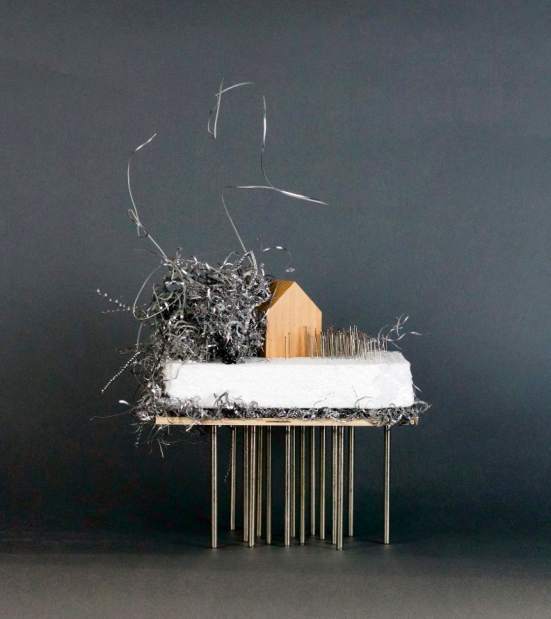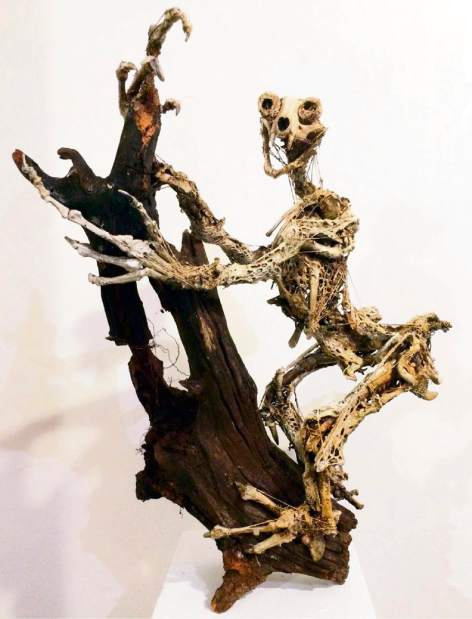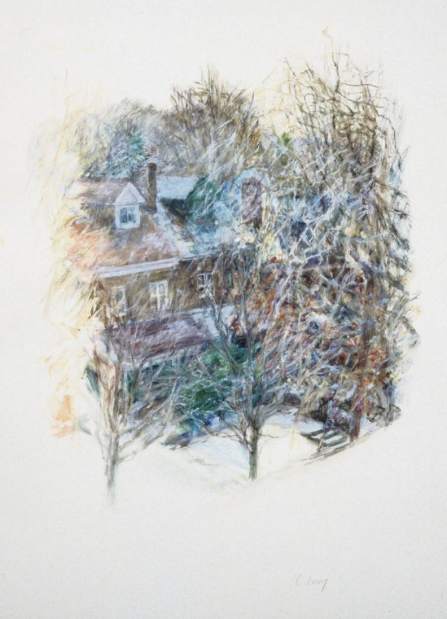Art review: 'No Boundaries: The Pittsburgh Group' and 'The Watcher The Watched' at BoxHeart
“No Boundaries,” on display at BoxHeart Gallery, features work by the Pittsburgh Group, whose monthly gatherings began 38 years ago as a result of a class taught by the late ceramicist Jerry Caplan at the Pittsburgh Center for the Arts.
The group, which is made up of 13 female artists who live in Southwestern Pennsylvania, has some original members and others who have been invited since then.
They critique each other's art and discuss techniques and concepts at their meetings. By sharing constructive advice, they clarify and elaborate upon individual visualizations in a way that's not possible when working in isolation.
As visitors will see, members of the group possess a distinct visual vocabulary while valuing the personal connections that have come about through the years.
For example, Debra Platt of Murrysville showcases a mixed-media piece, “Last Dance,” from a series called “Impermanence,” a central theme in Buddhism.
“Life is change, nothing is ever the same, and we have to let go. Attachment is the cause of suffering,” Platt says. " ‘Last Dance' is a series of three images of a butterfly I saw on the side of the road while on a walk, and while I marveled at its beauty, I was also saddened at it struggling with a last attempt at flight.”
Working more abstractly, Judy Musser of Somerset shows “Rhapsody,” an acrylic painting for which she says of her process: “I just make some marks and ‘jump' in. The fact that I work standing at an easel affects how the work progresses. ... I step back and forth a lot to view the work from a distance. ... this becomes a little dance I do with the canvas.”
The end result is the purely sensual pleasure of painting evident on canvas, restrained a bit by careful thought and observation.
Lorraine Levy of Squirrel Hill displays “Winter,” a gouache painting that evokes every bit the cold, icy feel of its title.
“I have always been most interested in what is happening in nature,” Levy says. “After my husband passed, I made a painting of the view outside my front window. It seemed to orient me and calm me. I returned again and again to do more pieces from this same vantage point, as it was always interesting and changing.”
After a yearlong renovation, BoxHeart has a second-floor gallery space. It's there that visitors will find another group exhibit, “The Watcher The Watched,” which features the work of five artists, some of whom are from Pittsburgh and others as far away as Ann Arbor, Mich.
This exhibit, says gallery director Nicole Capozzi, explores not only the use of media but also “the ability of the art object to examine the intent of the watcher and the experience of the watched.”
Whether contemplating their childhood, creativity, political strife, domesticity or safety, the five artists in the exhibit have imbued each of their works with a feeling that the viewer, too, is being watched.
For example, Kyle Ethan Fischer's “Aye-Eye” piece incorporates nontraditional materials, such as bones and doilies, into a figurative piece based on a type of lemur from Madagascar known as an Aye-aye.
It's a response to the static act of viewing and an exploration into his work's ability to challenge the power dynamics of the watcher and the watched.
Fischer says creating the piece was a challenge, a sort of visual pun that depicts a chimeralike creature with fantastical anatomy including things like jawbones to make a femur or motor parts, bullets, doilies or toy soldiers to represent other anatomical landmarks that encase a certain symbolism.
In similar fashion, multimedia artist Irina Koukhanova of Cleveland uses mythological figures of folklore to comment on and explore the spirit of upheaval in contemporary society.
Her installation “Rattenfanger” is based on the ancient story of the Pied Piper of Hamelin. Many versions of this folklore narrative exist and have appeared in the writings of Johann Wolfgang von Goethe, the Brothers Grimm and Robert Browning, among others.
The tale goes that a piper was hired by the town to lure rats away with his magic pipe. When the citizenry refuses to pay for this service, he retaliates by turning his power on their children, leading them away as he had done with the rats.
The work in the exhibit combines sculpture and painting and relies on a multitude of references. Viewers are put in between rats on the bottom and sentry crows above, while being confronted by the “family portraits” in the same space.
Then, there are the works of Carolyn Reed Barritt of Ann Arbor, whose sculptural “excerpts” reflect upon inhabitation and movement within an environment.
Using wood, sticks, acrylic ink and gesso, Barritt's process is not only deliberate but also emergent as she contrasts a watcher-and-watched relationship based on principles of trust with a relationship based on principles of domination.
For example, “Excerpt No. 6” is about our desire for control and safety, the artist says.
“I think we all want to feel in control of our lives, but too much control can lead to obsession,” Barritt says. “You can say a similar thing about feeling safe; about how our desire for safety can lead to fear.
“I wanted to show that it's impossible to control everything or to be completely safe, no matter how hard you try, and that a little chaos and lack of control is OK and maybe a good thing.”
Kurt Shaw is the art critic for Trib Total Media. He can be reached at kshaw@tribweb.com.




